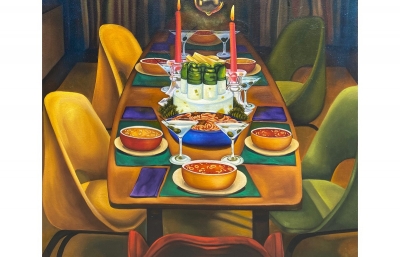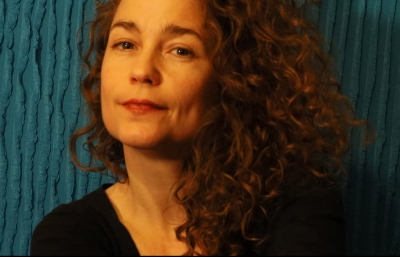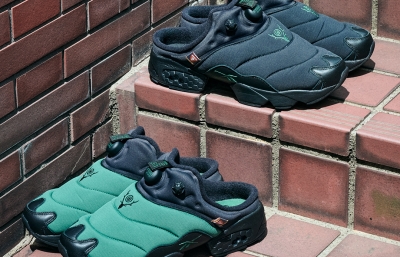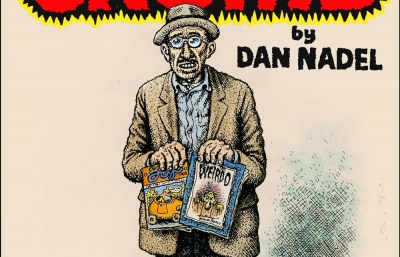I can attest to the magical properties of Adrian Schachter’s work because I wear it on my body. Under the name Adrian Cashmere, the artist creates sartorial selections unlike anything ever experienced in the medium of soft wool. My affinity grew before I knew of Schachter’s success as a gallery artist, or his family’s art world centrality. He had me at cashmere, but his art practice is expansive, and his work is known to sell out overnight due to a legion of luminary collectors.
Kristin Farr: Describe some of the reference images for your paintings.
Adrian Schachter: My source material comes from all over the internet: various social media, online collections, films, and forums. I also use generative AI. The images and concepts come from different places, but they’re always found through screens.
Do you use specific search terms?
There are not many recurring terms. Sometimes I’ll pepper searches with words like unusual, unique, rare, recently discovered, etc., trying to find non-fictional imagery that seems fantastical. 
Is it fair to say you have a tendency toward amalgamation?
That is true. It was born out of indecision, wanting to go left and right at the same time. For me, amalgamating images feels natural: It’s a reflection of my experience, like a desktop with multiple tabs open at the same time. I’m going for visual combinations that are jarring, unpredictable but are not in opposition to each other.
Tell me about your show at NYC’s Gratin last year.
The show was focused on two large paintings, both about the dancing mania of Strasbourg in 1518. I was thinking about faith, madness, conformity, and how one’s reality can be challenged. One painting was transposed with a fictional highway and the other with “The Library of Babel,” a short story by Jorge Luis Borges, as illustrated by Erik Desmazieres. I felt that these overlays highlighted the value of communication and the human network, as well as the effect they have on our belief systems.
Do you collect anything?
I love plants, but I have a hard time keeping them alive. I love to collect rocks, fossils and crystals because they’re nourishing to live with in the same way plants are, and they never die.
I’m drawn to ammonites because they remind me of my brother Kai, who’s no longer here. I love taxidermy. Specifically, Scottish Mizpahs, which are brooches made of grouse feet that you can gift as a good luck charm. I collect vintage clothing that I can reference to varying degrees. And I have a big screenshot collection that I’m always adding to.
How did your cashmere line come about?
I started making clothing for the same reason I’m drawn to ceramics: they are inherently functional objects. I love painting but am aware that it doesn’t have the same approachability. I want to also make objects that can be handled more readily. The more soft or texturally bizarre an object is, the more you're invited to touch it. It’s friendly and unpretentious. I was looking at a lot of knitwear, and I saw some empty space where I could exist in that ecosystem. More often than not, I saw knitwear graphics being treated preciously, whereas imagery sat much more casually on T-shirts.
I was named after my grandmother, so I named Adrian Cashmere after her and myself to encourage consumers to see the clothing as unisex. 
You’re a pioneer of printing on cashmere. How does it work?
Similarly to starting a painting, my design process starts with research. However, it's a more visually driven process. I will collect images, sometimes looking for other garments I can reference and modify. The first printed knits I made were meant to emulate worn-out vintage T- shirts. I referenced shirts printed with graphics of American cities and states. Because the end result had to be faithful to the originals, printing was the only way the images could exist. I reversed the images and printed them inside-out on semi-transparent fabric so they would look extra faded. This fabric is so comfortable and holds images so well that we continue to use it. It also encourages layering because it reveals but mutes whatever you wear underneath really nicely.
Many of my clothes relate to general narratives or rabbit holes: a quarter-zip, short-sleeve sweater had a zipper-pull shaped like the alien-like angels described in the book of Ezekiel. The shape was directly referencing a 19th-century fresco in St. John the Baptist Church in North Macedonia. Printed on the back is a medieval drawing of a four-leaf clover—Celtic good luck charms—and a simplified drawing of an ancient Egyptian figurine of a frog. I was merging spiritually ambiguous imagery from ancient cultures all over the world to hint at a mystical end point. Maybe this garment can be a talismanic good luck charm when you wear it.
These sources are not spelled out but they are recognized here and there, which lends the clothing an arcane element that can end up being so obscure it’s playful.
Does the balance between art and apparel feel seamless, like one big practice?
It does feel like one big art practice. Maybe different departments? Designing clothing after long periods of painting feels like when you’re in school and ready for the objectivity of a Math class after English.
You also make denim pieces where the button is a tiny head I’ve always wondered about...
The head came from a sculpture I made around the same time I started the brand. It was inspired by a German artist called Thomas Schutte. With the tongue falling out of its mouth, it looks kind of incapacitated, but it’s colored in enamel, like a little skittle. It makes me think that if it is suffering, it’s not taking itself too seriously. Playfulness is central to the ethos of the brand. I once heard that Andy Warhol used to walk around NYC with a bunch of jewelry hidden under his clothing. Despite the raised volume of some of the garments we make, they are made for the people who wear them, more than those who are looking at them. We just made this blue robe where, in the interior, we printed Liv Ullman’s tearful face from Ingmar Bergman’s Persona (1966) within a heart.
Is it fashion or wearable art, or is there a better term?
I feel like I’m more of a fashion appreciator than a fashion designer. Maybe it’s like folk fashion because my design process is not based in technical training and it’s approached from the perspective of an outsider. Calling them wearable art, in my mind, removes the garments from how I want them to exist. I wear the clothes I make for days at a time, sleep in them, and travel in them; their functionality comes first, despite originating from a painting studio context.
Tell me about the recent pieces designed by your brother Sage.
Sage and I both work in textiles, painting, and ceramics. He has been designing clothes informally for a while, and his stuff is beautiful. There are a lot of thematic crossovers in terms of humor and whimsy. He just made a tracksuit set with his tattoos knitted in faithfully to where they are on his body.
Tell me more about your family of artists.
It was the language we spoke growing up; that’s what I would come home to. Family discourse was one-track minded—we had no interest in sports or much else. I’m lucky that my parents have always been supportive. During COVID, my mom and I shared a studio, which was great.
What are your earliest memories of being affected by art?
I remember looking up at paintings by Misaki Kawaii and Christian Schumann. Both were so much fun to look at, but in vastly different ways. They had such pungently original visual language that was awe-inspiring.
Who has inspired you most as an artist, designer and person?
Being a toddler and hanging out in my Mom’s studio was a really formative experience. She was designing clothing and making paintings and installations at the time. It was the most thrilling place for me to be as a child. She stopped making art when I was six or seven, but thankfully, started again a couple years ago. 
Are you still working with your friend Caio Twombly, and who are some other people you’d like to work with?
My upcoming show is at Amanita, a gallery he co-founded in NYC. I showed at their space in Florence in 2022. I would love to collaborate with other artists, especially on clothing details. For example, it would be incredible to work with Franz West’s estate on making zippers or buttons inspired by his aluminum sculptures
Have you had any transcendental art experiences lately?
I watched The Moon is the Oldest TV recently, the Nam June Paik documentary, and was mesmerized. The ending, where you see footage of his installation at the Guggenheim rotunda, was the closest I ever got to being moved to tears by a work of art.
What’s the studio looking like recently, and what’s been on the playlist?
My studio is a little messy but actually pretty organized. I hate cleaning up, but I love to know where everything is. I can’t listen to music for more than a couple songs. I mostly have podcasts or audiobooks going at all times. I listen to a bunch of pods on rotation and artist talks on YouTube, and lately, a lot of comedy when I need to focus.
What’s coming up next?
We have a couple collaborations and new pieces coming out this year that I’m excited about. And after my show at Amanita, I want to spend time focusing on integrating my paintings into ceramics and learning about glaze chemistry.
AdrianCashmere.com // This interview was originally published in our SUMMER 2024 Quarterly






















